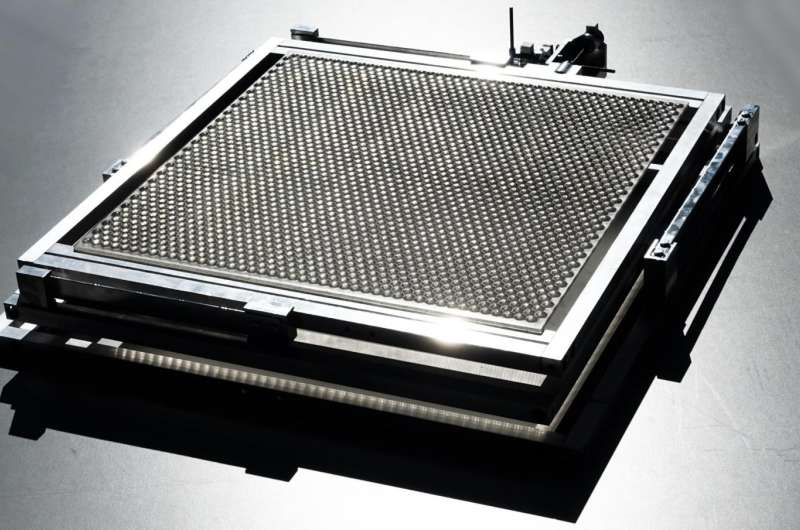Credit: Insolight
(Tech Xplore)—A Swiss startup has doubled residential solar panel efficiency. London-based Climate Action and other environment watching sites carried the report Monday.
The startup is Insolight and its team have been working on coming up with panels that have a 36 per cent yield. That number indicates the panels could deliver twice as much energy as traditional ones, said Climate Action.
Specifically, the numbers are a 36.4 per cent yield compared with 18 to 20 per cent for panels that are currently available.
Insolight said the 36.4% result, is a potential world record for a flat panel that can be mounted on a roof. The result was validated on a prototype by Germany's Fraunhofer Institute.
The Climate Action report described it as a "flat photovoltaic system," and as "a flat and thin optical system made of plastic which guides the sun's rays to the surface area of high performance cells, made from layers designed to capture differing wave lengths."
What else can be said about their technique? pv magazine had more on the topic. "The key to the cost reduction is to concentrate the sun's rays onto small areas of the high-efficiency cells, so you only have a small area of PV cell. To do this, Insolight has developed plastic lens, which can be layered on top of the solar cell, and which focus light from a larger area onto it. To do this the modules were also required to track the sun to concentrate the light."
Anther interesting remark on technique came from Laurent Coulot, CEO, in pv magazine. "Our idea was to concentrate the sunlight, but we want to do it in a flat panel assembly. So we have an optical system that allows you to redirect the sunlight without tilt, and this tracking system can move laterally by small strokes instead of rotating, so that you can insert it in the panel."
He said in Climate Action: "It's like a shower: all the water goes down one small drain, there's no need for the drain to cover the entire floor of the shower."
How much would it cost? Cost factors for new developments in the solar panel industry often involve an ouch factor. Engineers and scientists look at technology designs and often say, nice, but at what cost to produce enough electricity—and in turn is it practical.
In this instance, the upfront costs should not overtake the fact that in the long run this would make economic sense, in that the customer would get back value. At least that is the position of the team. Climate Action reported the COO, Florian Gerlich, as saying the system will probably be a little more expensive to buy, but will be quickly offset by the additional energy that will be generated.
The price of solar panels has dropped sharply in recent years, but not enough to produce electricity at a competitive cost, he observed. Gerlich made note that most of the margin earned by solar energy developers comes from subsidies—and these subsidies are declining.
So what is next? The team said, "We are gearing up towards the first pilot site!"
Coulot said in pv magazine that "The target is to have the first pilot size array running for September 2017. Then the next goal is to go to production, eventually heading to mass production."
Coulot in an interview with venturelab, meanwhile, talked about how the idea of the startup came about.
"I got to work with various solar cells technologies and realized that technologies which are scalable on large areas were always limited in terms of efficiency, mostly at less than 20%. Our idea was to move the problem from semiconductors to optics: we designed a novel solution to simplify the sun tracking and light concentration," he said.
More information: insolight.ch/efficiency-record-36-4/
© 2016 Tech Xplore
























